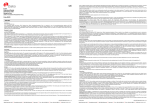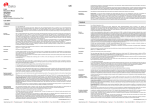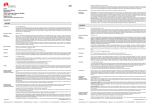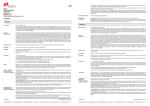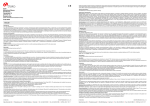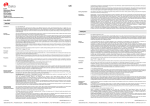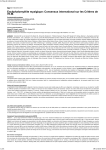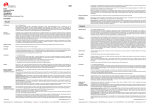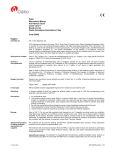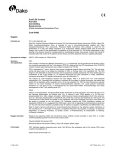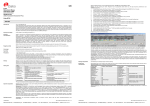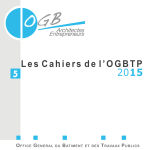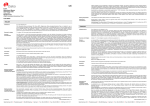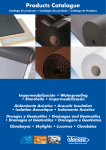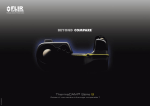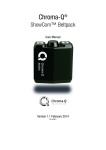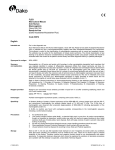Download FLEX Monoclonal Mouse Anti-Human CD21 Clone 1F8
Transcript
Staining interpretation Cells labeled by the antibody display membrane staining. Performance characteristics Normal tissues: In reactive lymphoid hyperplasia, the antibody strongly labels germinal centre FDCs in 11/11 cases, with a densely meshed FDC staining of the light zone and a loosely arranged, much less compact FDC staining of the dark zone. The antibody labels plasma cells, and gives a faint and less consistent labeling of lymphocytes in the mantle zone. Sinus-lining cells and monocytoid B cells are weakly labeled (1). The follicular dendritic cells in the germinal centers of tonsil show a moderate to strong staining reaction, whereas a subset of activated B cells in the mantle zone show a weak to moderate staining reaction. FLEX Monoclonal Mouse Anti-Human CD21 Clone 1F8 Ready-to-Use (Dako Autostainer/Autostainer Plus) Abnormal tissues: In 6 cases of B-cell chronic lymphocytic leukemia, the antibody showed weak surface labeling of neoplastic cells in four cases, and labeled FDCs in the sparse residual germinal centres in four cases. In 8/8 mantle cell lymphomas, the antibody labeled loosely arranged, ill-defined, and expanded FDC meshworks of either nodular or diffuse patterns, resembling broken-up primary follicles. In 11/11 follicular lymphomas, the abnormal follicles demonstrated dense, sharply defined, expanded and sometimes merging FDC meshworks. However, only loose and patchy FDC labeling was observed in five cases with high-grade transformation in the areas of diffuse large cell lymphoma. In 7/7 low-grade MALT-type B-cell lymphomas, the antibody labeled expanded FDC meshworks, with particularly dense and confluent appearance in cases of primary salivary gland and gastric lymphomas. In 5/5 T-cell and histiocyte-rich B-cell lymphomas, the antibody labeled a few compressed residual follicles at the periphery of the lymphomatous involvement. In 9/9 angioimmunoblastic T-cell lymphomas, clusters of dendritic cells with FDC morphology appeared with frequent incorporation of proliferating postcapillary venules. In 4/4 nodular lymphocyte predominance Hodgkin’s lymphomas, the antibody labeled enlarged FDC meshworks overlapping the expanded mantle zones. In 15 cases of Hodgkin’s lymphoma of nodular sclerosing subtype, the antibody labeled sharply defined, sometimes irregular FDC meshworks surrounding the negative tumor cells in 11 cases of grade l, and showed sparse or no labeling in 4 cases of grade ll disease (1). In follicular dendritic sarcoma, the antibody labeled neoplastic cells in 17/17 cases (5). In another study (6) the antibody labeled Reed-Sternberg and Hodgkin’s cells in 7/37 cases of nodular sclerosing, 2/41 cases of mixed cellularity, and 5/12 cases of lymphocyte depletion Hodgkin’s lymphoma, whereas no labeling of tumor cells was observed in 4 cases of lymphocyte predominance type. In nine of the cases where Reed-Sternberg and Hodgkin’s cells were labeled by the antibody, the cells expressed no other B- or T-cell associated markers (6). Code IS608 ENGLISH For in vitro diagnostic use. Intended use FLEX Monoclonal Mouse Anti-Human CD21, Clone 1F8, Ready-to-Use, (Dako Autostainer/Autostainer Plus), is intended for use in immunohistochemistry together with Dako Autostainer/Autostainer Plus instruments. This antibody labels follicular dendritic cells and mature B cells and is useful for the identification of structural alterations in the meshwork of follicular dendritic cells, which are frequently found in malignant lymphomas (1). The clinical interpretation of any staining or its absence should be complemented by morphological studies using proper controls and should be evaluated within the context of the patient's clinical history and other diagnostic tests by a qualified pathologist. Synonyms for antigen C3d-receptor, CR2, EBV-receptor (2). Summary and explanation CD21 is a transmembrane glycoprotein belonging to a family of complement regulatory proteins, comprising CD35, C4-binding protein, factor H and CD55. CD21 has a Mr of 145 000 and in its soluble form, sCD21, a Mr of 130 000. The extracellular region consists of multiple short consensus repeats, which contain several distinct ligand-binding sites. Binding of the specific ligands results in differential transmembrane signalling via the cytoplasmic tail that has potential protein kinase C and tyrosine kinase phosphorylation sites (2, 3). CD21 is expressed by follicular dendritic cells (FDCs) and mature B cells (3). FDCs form a three-dimensional meshwork in B-cell follicles, which apparently defines the structure of the follicular compartment (1). On lymphoid tissue B cells, CD21 expression is strong on marginal zone, and moderate on mantle zone B cells. Germinal centre B cells have been found to be negative with most CD21 mAbs, and bone marrow B cells have little or no CD21 expression. The expression of CD21 is gradually lost, together with IgD, after stimulation of resting B cells in vitro. Further, CD21 has been found on several types of epithelial cells, and with low expression on T-cell acute lymphoblastic leukemic cells, subsets of normal thymocytes, and mature T cells (3). FRANÇAIS Pour utilisation diagnostique in vitro. Utilisation prévue FLEX Monoclonal Mouse Anti-Human CD21, clone 1F8, Ready-to-Use, (Dako Autostainer/Autostainer Plus) est destiné à une utilisation en immunohistochimie avec les instruments Dako Autostainer/Autostainer Plus. Cet anticorps marque les cellules dendritiques folliculaires et les lymphocytes B matures et facilite l’identification des altérations structurelles dans le tissu de cellules dendritiques folliculaires, qui sont souvent présentes dans les lymphomes malins (1). L’interprétation clinique de toute coloration ou son absence doit être complétée par des études morphologiques en utilisant des contrôles appropriés et doit être évaluée en fonction des antécédents cliniques du patient et d’autres tests diagnostiques par un pathologiste qualifié. Synonymes de l’antigène Récepteur de C3d, CR2, récepteur de l’EBV (2). Résumé et explication La CD21 est une glycoprotéine transmembranaire qui appartient à une famille de protéines régulatrices du complément, comprenant la CD35, la protéine de liaison C4, le facteur H et la CD55. La CD21 a une masse moléculaire de 145 000 et, dans sa forme soluble, sCD21, une masse moléculaire de 130 000. La région extracellulaire comprend de nombreuses répétitions de nombreuses séquences courtes, qui comportent plusieurs sites de liaison des ligands distincts. La liaison de ligands spécifiques se traduit par une signalisation transmembranaire différentielle via la queue cytoplasmique qui peut comporter des sites de phosphorylation de la protéine kinase C et de la tyrosine kinase (2, 3). Refer to Dako’s General Instructions for Immunohistochemical Staining or the detection system instructions of IHC procedures for: 1) Principle of Procedure, 2) Materials Required, Not Supplied, 3) Storage, 4) Specimen Preparation, 5) Staining Procedure, 6) Quality Control, 7) Troubleshooting, 8) Interpretation of Staining, 9) General Limitations. La CD21 est exprimée par les cellules dendritiques folliculaires et les lymphocytes B matures (3). Les dendritiques folliculaires forment un tissu tridimensionnel de follicules des lymphocytes B, qui définit apparemment la structure du compartiment folliculaire (1). Sur les lymphocytes B du tissu lymphoïde, l’expression de la CD21 est forte sur une zone marginale et modérée sur les lymphocytes B de la zone du manteau. Les lymphocytes B du centre germinatif se sont avéré être négatifs à la plupart des mAb de la CD21, et les lymphocytes B de la moelle osseuse présentent une expression très faible, voire aucune expression, de la CD21. L’expression de la CD21 se perd progressivement, en même temps que les IgD, après stimulation des lymphocytes B au repos in vitro. En outre, la CD21 s’avère présente sur plusieurs types de cellules épithéliales, et s’accompagne d’une faible expression sur les cellules de leucémies lymphoblastiques aiguës à lymphocytes T, de sous-ensembles de thymocytes normaux, et de lymphocytes T matures (3). Ready-to-use monoclonal mouse antibody provided in liquid form in a buffer containing stabilizing protein and 0.015 mol/L sodium azide. Reagent provided Clone: 1F8 (4). Isotype: IgG1, kappa. Immunogen CD21 preparation purified from human tonsils to 60% purity (4). Specificity In Western blotting of the immunogen, the antibody labels a band of 145 kDa, corresponding to CD21. The epitope recognized by the antibody is located within a 72 kDa C3d-binding fragment (4). Precautions Se référer aux Instructions générales de coloration immunohistochimique de Dako ou aux instructions du système de détection relatives aux procédures IHC pour plus d’informations concernant les points suivants : 1) Principe de procédure, 2) Matériels requis mais non fournis, 3) Conservation, 4) Préparation des échantillons, 5) Procédure de coloration, 6) Contrôle qualité, 7) Dépannage, 8) Interprétation de la coloration, 9) Limites générales. Anticorps monoclonal de souris prêt à l’emploi fourni sous forme liquide dans un tampon contenant une protéine stabilisante et 0,015 mol/L d’azide de sodium. The antibody labels cells or cell lines known to express CD21 (Raji, NC 37, tonsil cells), whereas no labeling is observed in the CD21-negative Jurkat cells (Tcell line) and human erythrocytes (4). Réactifs fournis 1. For professional users. 2. This product contains sodium azide (NaN3), a chemical highly toxic in pure form. At product concentrations, though not classified as hazardous, sodium azide may react with lead and copper plumbing to form highly explosive build-ups of metal azides. Upon disposal, flush with large volumes of water to prevent metal azide build-up in plumbing. 3. As with any product derived from biological sources, proper handling procedures should be used. 4. Wear appropriate Personal Protective Equipment to avoid contact with eyes and skin. 5. Unused solution should be disposed of according to local, State and Federal regulations. Immunogène Préparation de CD21 purifiée issue d'amygdale humaine à une pureté de 60 % (4). Spécificité Dans les analyses par Western blot de l’immunogène, l’anticorps marque des bandes de 145 kDa correspondant à la CD21. L’épitope reconnu par l’anticorps est situé au sein d'un fragment de liaison de la C3d de 72 kDa (4). Clone : 1F8 (4). Isotype : IgG1, kappa. L’anticorps marque les cellules ou lignées cellulaires connues pour exprimer la CD21 (Raji, NC 37, cellules d’amygdale), alors qu’aucun marquage n’est observé dans les cellules de Jurkat négatives à la CD21 (lignée de lymphocytes T) et dans les érythrocytes humains (4). Précautions 1. Pour utilisateurs professionnels. 2. Ce produit contient de l’azide de sodium (NaN3), produit chimique hautement toxique dans sa forme pure. Aux concentrations du produit, bien que non classé comme dangereux, l’azide de sodium peut réagir avec le cuivre et le plomb des canalisations et former des accumulations d’azides métalliques hautement explosifs. Lors de l’élimination, rincer abondamment à l’eau pour éviter toute accumulation d’azide métallique dans les canalisations. 3. Comme avec tout produit d’origine biologique, des procédures de manipulation appropriées doivent être respectées. 4. Porter un vêtement de protection approprié pour éviter le contact avec les yeux et la peau. 5. Les solutions non utilisées doivent être éliminées conformément aux réglementations locales et nationales. Conservation Conserver entre 2 et 8 °C. Ne pas utiliser après la date de péremption indiquée sur le flacon. Si les réactifs sont conservés dans des conditions autres que celles indiquées, celles-ci doivent être validées par l’utilisateur. Il n’y a aucun signe évident indiquant l’instabilité de ce produit. Par conséquent, des contrôles positifs et négatifs doivent être testés en même temps que les échantillons de patient. Si une coloration inattendue est observée, qui ne peut être expliquée par un changement des procédures du laboratoire, et en cas de suspicion d’un problème lié à l’anticorps, contacter l’assistance technique de Dako. Préparation des échantillons y compris le matériel requis mais non fourni L’anticorps peut être utilisé pour le marquage des coupes de tissus inclus en paraffine et fixés au formol. L'épaisseur des coupes d'échantillons de tissu doit être d’environ 4 µm. Store at 2–8 °C. Do not use after expiration date sta mped on vial. If reagents are stored under any conditions other than those specified, the conditions must be verified by the user. There are no obvious signs to indicate instability of this product. Therefore, positive and negative controls should be run simultaneously with patient specimens. If unexpected staining is observed which cannot be explained by variations in laboratory procedures and a problem with the antibody is suspected, contact Dako Technical Support. Storage Specimen preparation including materials required but not supplied The antibody can be used for labeling formalin-fixed, paraffin-embedded tissue sections. Tissue specimens should be cut into sections of approximately 4 µm. Pre-treatment with heat-induced epitope retrieval (HIER) is required. Optimal results are obtained by pretreating tissues using EnVision FLEX, Target Retrieval Solution, Low pH (10x), (Dako Autostainer/Autostainer Plus) (Code K8015). Deparaffinized sections: Pre-treatment of deparaffinized formalin-fixed, paraffin-embedded tissue sections is recommended using Dako PT Link (Code PT100/PT101). For details, please refer to the PT Link User Guide. Follow the pre-treatment procedure outlined in the package insert for EnVision FLEX, Target Retrieval Solution, Low pH (10x), (Dako Autostainer/Autostainer Plus) (Code K8015). The following parameters should be used for PT Link: Pre-heat temperature: 65 °C; epito pe retrieval temperature and time: 97 °C for 20 (±1 ) minutes; cool down to 65 °C. Remove Autostainer slide rack with s lides from the PT Link tank and immediately dip slides into a jar/tank (e.g. PT Link Rinse Station, Code PT109) containing diluted room temperature EnVision FLEX Wash Buffer (10x), (Dako Autostainer/Autostainer Plus) (Code K8012). Leave slides in Wash Buffer for 1–5 minutes. Paraffin-embedded sections: As alternative specimen preparation, both deparaffinization and epitope retrieval can be performed in the PT Link using a modified procedure. See the PT Link User Guide for instructions. After the staining procedure has been completed, the sections must be dehydrated, cleared and mounted using permanent mounting medium. Coupes déparaffinées : Le prétraitement des coupes de tissus déparaffinés fixés au formol et inclus en paraffine est recommandé à l’aide du Dako PT Link (Réf. PT100/PT101). Pour plus de détails, se référer au Guide d’utilisation du PT Link. The tissue sections should not dry out during the treatment or during the following immunohistochemical staining procedure. For greater adherence of tissue sections to glass slides, the use of Dako Silanized Slides (Code S3003) is recommended. Staining procedure including materials required but not supplied Suivre la procédure de pré-traitement indiquée dans la notice pour la EnVision FLEX Target Retrieval Solution, Low pH (10x), (Dako Autostainer/Autostainer Plus) (Réf. K8015). Les paramètres suivants doivent être utilisés pour le PT Link : température de préchauffage : 65 °C ; température et durée de restauration de l’épitope : 97 °C pendant 20 (±1) minutes ; laisser re froidir jusqu’à 65 °C. Retirer le portoir à lames et les lames Autostainer de la cuve du PT Link et plonger immédiatement les lames dans un récipient/une cuve (ex. : PT Link Rinse Station, Réf. PT109) contenant du EnVision FLEX Wash Buffer (10x), (Dako Autostainer/Autostainer Plus) (Réf. K8012) dilué à température ambiante. Laisser les lames dans le Wash Buffer pendant 1–5 minutes. The recommended visualization system is EnVision FLEX+, Mouse, High pH, (Dako Autostainer/Autostainer Plus) (Code K8012), replacing the High pH Target Retrieval Solution from this kit with EnVision FLEX Target Retrieval Solution, Low pH (10x), (Dako Autostainer/Autostainer Plus) (Code K8015). The staining steps and incubation times are pre-programmed into the software of Dako Autostainer/Autostainer Plus instruments, using the following protocols: Coupes incluses en paraffine : Comme préparation alternative des échantillons, le déparaffinage et la restauration de l’épitope peuvent être réalisés dans le PT Link à l’aide d’une procédure modifiée. Se référer aux instructions du Guide d’utilisation du PT Link. Une fois que la procédure de coloration est terminée, les coupes doivent être déshydratées, lavées et montées à l’aide d’un milieu de montage permanent. Template protocol: FLEXRTU2 (200 µL dispense volume) or FLEXRTU3 (300 µL dispense volume) Autoprogram: CD21 (without counterstaining) or CD21H (with counterstaining) The Auxiliary step should be set to “rinse buffer” in staining runs with ≤10 slides. For staining runs with >10 slides the Auxiliary step should be set to “none”. This ascertains comparable wash times. All incubation steps should be performed at room temperature. For details, please refer to the Operator’s Manual for the dedicated instrument. If the protocols are not available on the used Dako Autostainer instrument, please contact Dako Technical Services. Optimal conditions may vary depending on specimen and preparation methods, and should be determined by each individual laboratory. If the evaluating pathologist should desire a different staining intensity, a Dako Application Specialist/Technical Service Specialist can be contacted for information on reprogramming of the protocol. Verify that the performance of the adjusted protocol is still valid by evaluating that the staining pattern is identical to the staining pattern described in “Performance characteristics”. Les coupes de tissus ne doivent pas sécher lors du traitement ou lors de la procédure de coloration immunohistochimique suivante. Pour une meilleure adhérence des coupes de tissus sur les lames de verre, il est recommandé d’utiliser des lames Dako Silanized Slides (Réf. S3003). Procédure de coloration y compris le matériel requis mais non fourni Autoprogram : CD21 (sans contre-coloration) ou CD21H (avec contre-coloration) L’étape Auxiliary doit être réglée sur « rinse buffer » lors des cycles de coloration avec ≤10 lames. Pour les cycles de coloration de >10 lames, l’étape Auxiliary doit être réglée sur « none ». Positive and negative controls should be run simultaneously using the same protocol as the patient specimens. The positive control tissue should include tonsil and the cells/structures should display reaction patterns as described for this tissue in “Performance characteristics” in all positive specimens. The recommended negative control reagent is FLEX Negative Control, Mouse, (Dako Autostainer/Autostainer Plus) (Code IS750). Dako Denmark A/S IS608/EFG/LPF/25.04.08 p. 1/4 | Produktionsvej 42 | DK-2600 Glostrup | Denmark | Tel. +45 44 85 95 00 | Fax +45 44 85 95 95 | CVR No. 33 21 13 17 Le système de visualisation recommandé est EnVision FLEX+, Mouse, High pH, (Dako Autostainer/Autostainer Plus) (Réf. K8012), remplaçant la High pH Target Retrieval Solution de ce kit par la EnVision FLEX Target Retrieval Solution, Low pH (10x), (Dako Autostainer/Autostainer Plus) (Réf. K8015). Les étapes de coloration et les temps d’incubation sont préprogrammés dans le logiciel Dako Autostainer/Autostainer Plus des instruments, à l’aide des protocoles suivants : Protocole modèle : FLEXRTU2 (volume de distribution de 200 µL) ou FLEXRTU3 (volume de distribution de 300 µL) Counterstaining in hematoxylin is recommended using EnVision FLEX Hematoxylin, (Dako Autostainer/Autostainer Plus) (Code K8018). Non-aqueous, permanent mounting medium is recommended. (115312-003) Le prétraitement avec un démasquage d’épitope induit par la chaleur (HIER) est nécessaire. Des résultats optimaux sont obtenus en prétraitant les tissus à l’aide de la EnVision FLEX Target Retrieval Solution, Low pH (10x), (Dako Autostainer/Autostainer Plus) (Réf. K8015). (115312-003) Dako Denmark A/S IS608/EFG/LPF/25.04.08 p. 2/4 | Produktionsvej 42 | DK-2600 Glostrup | Denmark | Tel. +45 44 85 95 00 | Fax +45 44 85 95 95 | CVR No. 33 21 13 17 Toutes les étapes d’incubation doivent être effectuées à température ambiante. Pour plus de détails, se référer au Manuel de l’opérateur spécifique à l'instrument. Si les protocoles ne sont pas disponibles sur l’instrument Dako Autostainer utilisé, contacter le service technique de Dako. Paraffineingebettete Schnitte: Zur Probenpräparation kann für Entparaffinierung und Epitopdemaskierung im PT Link auch ein modifiziertes Verfahren verwendet werden. Weitere Informationen siehe PT Link-Benutzerhandbuch. Nach Abschluss des Färbeverfahrens müssen die Schnitte dehydriert, geklärt und unter Verwendung eines permanenten Fixiermittels auf die Objektträger aufgebracht werden. Les conditions optimales peuvent varier en fonction du prélèvement et des méthodes de préparation, et doivent être déterminées par chaque laboratoire individuellement. Si le pathologiste qui réalise l’évaluation désire une intensité de coloration différente, un spécialiste d’application/spécialiste du service technique de Dako peut être contacté pour obtenir des informations sur la re-programmation du protocole. Vérifier que l'exécution du protocole modifié est toujours valide en vérifiant que le schéma de coloration est identique au schéma de coloration décrit dans les « Caractéristiques de performance ». Il est recommandé d’effectuer une contre-coloration à l’aide de EnVision FLEX Hematoxylin, (Dako Autostainer/Autostainer Plus) (Réf. K8018). L’utilisation d’un milieu de montage permanent non aqueux est recommandée. Des contrôles positifs et négatifs doivent être réalisés en même temps et avec le même protocole que les échantillons du patient. Le contrôle de tissu positif doit comprendre l’amygdale et les cellules/structures doivent présenter des schémas de réaction tels que décrits pour ces tissus dans les « Caractéristiques de performance » pour tous les échantillons positifs. Le contrôle négatif recommandé est le FLEX Negative Control, Mouse, (Dako Autostainer/Autostainer Plus) (Réf. IS750). Die Gewebeschnitte dürfen während der Behandlung oder während des anschließenden immunhistochemischen Färbeverfahrens nicht austrocknen. Zur besseren Haftung der Gewebeschnitte an den Glasobjektträgern werden Dako Silanized Slides (Code-Nr. S3003) empfohlen. Färbeverfahren und erforderliche, aber nicht mitgelieferte Materialien Les cellules marquées par l’anticorps présentent une coloration membranaire. Caractéristiques de performance Tissus sains : Dans l’hyperplasie lymphoïde réactive, l’anticorps marque fortement les cellules dendritiques folliculaires du centre germinatif dans 11 cas sur 11, avec une coloration des cellules dendritiques folliculaires fortement intriquée dans la zone claire et une coloration des cellules dendritiques folliculaires organisées de manière plus libre, et moins compacte dans la zone sombre. L’anticorps marque les cellules plasmatiques et entraîne un marquage faible et moins homogène des lymphocytes de la zone du manteau. Les cellules de la paroi sinusale et les lymphocytes B monocytoïdes sont faiblement marqués (1). Les cellules dendritiques folliculaires des centres germinatifs des amygdales présentent une coloration modérée à forte, tandis que la coloration d’un sous-ensemble de lymphocytes B activés est faible à modérée. Tissus tumoraux : Dans 6 cas de leucémie lymphocytaire chronique à lymphocytes B, l’anticorps entraîne un marquage de surface faible des cellules néoplasiques dans quatre cas, ainsi qu’un marquage des cellules dendritiques folliculaires dans les centres germinatifs résiduels épars dans quatre cas. Dans 8 cas sur 8 de lymphome à cellules du manteau, l’anticorps a marqué des tissus de cellules dendritiques folliculaires étendus, mal définis et peu denses soit nodulaires soit diffus, ressemblant à des follicules primaires brisés. Dans 11 cas sur 11 de lymphome folliculaire, les follicules anormaux ont présenté un tissu de cellules dendritiques folliculaires dense, nettement défini, étendu et parfois fusionnant. Cependant, seul un marquage des cellules dendritiques folliculaires peu denses et réparties de manière irrégulière a été observé dans cinq cas avec une transformation de haut grade dans les zones de lymphome diffus à grandes cellules. Dans 7 cas sur 7 de lymphome à lymphocytes B de type MALT de faible grade, l’anticorps a marqué des tissus de cellules dendritiques folliculaires étendus, avec une apparence particulièrement dense et confluente dans les cas de lymphomes primaires gastriques et des glandes salivaires. Dans 5 cas sur 5 de lymphome à lymphocytes T et de lymphomes à lymphocytes B riches en histiocytes, l’anticorps a marqué quelques follicules résiduels comprimés à la périphérie de l’engagement lymphomateux. Dans 9 cas sur 9 de lymphome à lymphocytes T angioimmunoblastiques, des foyers de cellules dendritiques ayant une morphologie de cellules dendritiques folliculaires sont apparus avec une incorporation fréquente de veinules post-capillaires proliférantes. Dans 4 cas sur 4 de lymphome hodgkinien nodulaire à prédominance lymphocytaire, l’anticorps a marqué des tissus de cellules dendritiques folliculaires étendus chevauchant les zones du manteau étendues. Dans 15 cas de lymphome d’Hodgkin de sous-type nodulaire sclérosant, l’anticorps a marqué des tissus de cellules dendritiques folliculaires nettement définis, parfois irréguliers entourant des cellules tumorales négatives dans 11 cas de grade l, et a présenté un marquage épars, voire aucun marquage dans 4 cas de grade ll (1). Dans le sarcome dendritique folliculaire, l’anticorps a marqué les cellules néoplasiques dans 17 cas sur 17 (5). Dans une autre étude (6), l’anticorps a marqué des cellules de Reed-Sternberg et d'Hodgkin dans 7 cas sur 37 de maladie nodulaire sclérosante, 2 cas sur 41 de lymphome à cellularité mixte, et 5 cas sur 12 de lymphome hodgkinien à déplétion lymphocytaire, alors qu’aucun marquage de cellules tumorales n’a été observé dans 4 cas de type à prédominance lymphocytaire. Dans 9 de ces cas où des cellules de Reed-Sternberg et de Hodgkin étaient marquées par l’anticorps, les cellules n’ont exprimé aucun autre marqueur associé aux lymphocytes B ou T (6). Matrix-Protokoll: FLEXRTU2 (200 µL Abgabevolumen) oder FLEXRTU3 (300 µL Abgabevolumen) Autoprogram: CD21 (ohne Gegenfärbung) oder CD21H (mit Gegenfärbung) Alle Inkubationsschritte sollten bei Raumtemperatur durchgeführt werden. Nähere Einzelheiten bitte dem Benutzerhandbuch für das jeweilige Gerät entnehmen. Wenn die Färbeprotokolle auf dem verwendeten Dako Autostainer-Gerät nicht verfügbar sind, bitte den Technischen Kundendienst von Dako verständigen. Optimale Bedingungen können je nach Probe und Präparationsverfahren unterschiedlich sein und sollten vom jeweiligen Labor selbst ermittelt werden. Falls der beurteilende Pathologe eine andere Färbungsintensität wünscht, kann ein Anwendungsspezialist oder Kundendiensttechniker von Dako bei der Neuprogrammierung des Protokolls helfen. Die Leistung des angepassten Protokolls muss verifiziert werden, indem gewährleistet wird, dass das Färbemuster mit dem unter „Leistungsmerkmale“ beschriebenen Färbemuster identisch ist. Die Gegenfärbung in Hämatoxylin sollte mit EnVision™ FLEX Hematoxylin (Dako Autostainer/Autostainer Plus) (Code-Nr. K8018) ausgeführt werden. Empfohlen wird ein nichtwässriges, permanentes Fixiermittel. Positiv- und Negativkontrollen sollten zur gleichen Zeit und mit demselben Protokoll wie die Patientenproben getestet werden. Das positive Kontrollgewebe sollte Mandelgewebe enthalten und die Zellen/Strukturen müssen in allen positiven Proben die für dieses Gewebe unter „Leistungsmerkmale“ beschriebenen Reaktionsmuster aufweisen. Das empfohlene Negativ-Kontrollreagenz ist FLEX Negative Control, Mouse (Dako Autostainer/Autostainer Plus) (Code-Nr. IS750). Auswertung der Färbung Mit diesem Antikörper markierte Zellen weisen eine Membranfärbung auf. Leistungsmerkmale Gesundes Gewebe: Bei reaktiver lymphoider Hyperplasie markiert der Antikörper Keimzentrum-FDCs in 11 von 11 Fällen stark mit einer dicht vernetzten FDCFärbung der hellen Zone und einer locker angeordneten, viel weniger kompakten FDC-Färbung der dunklen Zone. Der Antikörper markiert Plasmazellen und erzeugt eine schwache und weniger konsistente Markierung von Lymphozyten in der Mantelzone. Sinusdeckzellen und monozytoide B-Zellen werden schwach markiert (1). Die follikulären dendritischen Zellen im Keimzentrum der Mandeln zeigen eine mäßige bis starke Färbereaktion, während eine Untergruppe aktivierter B-Zellen in der Mantelzone eine schwache bis mäßige Färbereaktion zeigen. Pathologisches Gewebe: In 6 Fällen von chronischer lymphozytärer B-Zellen-Leukämie zeigte der Antikörper eine schwache Oberflächenmarkierung neoplastischer Zellen in vier Fällen und markierte FDCs in vereinzelten Keimzentrumsresten in vier Fällen. In 8 von 8 Mantelzelllymphomen markierte der Antikörper locker angeordnete, schlecht definierte und erweiterte FDC-Netzwerke von nodulärer oder diffuser Gestalt, die gebrochenen primären Follikeln ähneln. In 11 von 11 follikulären Lymphomen zeigten die pathologischen Follikel dichte, klar definierte, erweiterte und manchmal sich mischende FDC-Netzwerke. Allerdings wurde in fünf Fallen mit hoher Transformation in den Bereichen mit diffusem großzelligem Lymphom nur vereinzelt lockere FDC-Markierung beobachtet. In 7 von 7 niedriggradigen MALT-Typ B-Zellen-Lymphomen markierte der Antikörper erweiterte FDC-Netzwerke mit besonders dichter und konfluenter Erscheinung in Fällen von primären Speicheldrüsen- und Magenlymphomen. In 5 von 5 T-Zell- und histiozytenreichen B-Zell-Lymphomen markierte der Antikörper einige komprimierte Restfollikel im Peripheriebereich des lymphomatosen Bereichs. In 9 von 9 angioimmunblastischen T-Zell-Lymphomen erschienen Gruppen dendritischer Zellen mit FDC-Morphologie mit häufiger Aufnahme proliferierender postkapillarer Venolen. In 4 von 4 nodulären, durch Prädominanz von Lymphozyten gekennzeichneten Hodgkin-Lymphomen markierte der Antikörper vergrößerte FDC-Netzwerke, die die erweiterten Mantelzonen überlappen. In 15 Fällen von Hodgkin-Lymphomen des nodulären, sklerosierenden Untertyps markierte der Antikörper klar definierte, manchmal unregelmäßige FDC-Netzwerke um die negativen Tumorzellen in 11 Fällen mit Grad I und zeigte zerstreute oder keine Markierung in 4 Fällen mit Grad-II-Erkrankung (1). Bei follikulärem dendritischem Sarkom markierte der Antikörper neoplastische Zellen in 17 von 17 Fällen (5). In einer anderen Studie (6) markierte der Antikörper Reed-Sternberg- und Hodgkin-Zellen in 7 von 37 Fällen von nodulär sklerosierendem, 2 von 41 Fällen von gemischtzelligem und 5 von 12 Fällen von lymphozytenarmem Hodgkin-Lymphom, wohingegen keine Markierung von Tumorzellen in 4 Fällen des durch Prädominanz von Lymphozyten gekennzeichneten Typs beobachtet wurde. In neun Fällen, in denen ReedSternberg- und Hodgkin-Zellen durch den Antikörper markiert wurden, exprimierten die Zellen keine anderen auf B- oder T-Zellen bezogenen Marker (6). DEUTSCH Zur In-vitro-Diagnostik. FLEX Monoclonal Mouse Anti-Human CD21, Clone 1F8, Ready-to-Use (Dako Autostainer/Autostainer Plus) ist zur Verwendung in der Immunhistochemie in Verbindung mit Dako Autostainer/Autostainer Plus-Geräten bestimmt. Der Antikörper markiert follikuläre dendritische Zellen und reife B-Zellen und dient zur Identifizierung struktureller Veränderungen im Netzwerk der follikulären dendritischen Zellen, die häufig in bösartigen Lymphomen auftreten (1). Die klinische Auswertung einer eventuell eintretenden Färbung sollte durch morphologische Studien mit geeigneten Kontrollen ergänzt werden und von einem qualifizierten Pathologen unter Berücksichtigung der Krankengeschichte und anderer diagnostischer Tests des Patienten vorgenommen werden. Synonyme für das Antigen C3d-Rezeptor, CR2, EBV-Rezeptor (2). Zusammenfassung und Erklärung CD21 ist ein transmembranes Glykoprotein aus der Familie komplementregulierender Proteine, wie u. a. CD35, C4-bindendes Protein, Faktor H und CD55. CD21 hat ein Mr von 145.000 und in seiner löslichen Form, sCD21, ein Mr von 130.000. Die extrazelluläre Region besteht aus mehreren Kurzkonsenswiederholungen, die mehrere klare ligandenbindende Stellen enthalten. Die Bindung der spezifischen Liganden ergibt eine differenzielle transmembranöse Signaltransduktion über den zytoplasmatischen Schwanz, der potenzielle Phosphorylierungsstellen von Proteinkinase C und Tyrosinkinase aufweist (2, 3). CD21 wird von follikulären dendritischen Zellen (FDCs) und reifen B-Zellen exprimiert (3). FDCs bilden ein dreidimensionales Netzwerk in B-Zellfollikeln, was anscheinend die Struktur des follikulären Kompartiments definiert (1). Auf B-Zellen von lymphoidem Gewebe ist die CD21-Expression in Randzonen stark und in Mantelzonen-B-Zellen moderat ausgeprägt. Keimzentrum-B-Zellen wurden mit den meisten CD21 mAbs als negativ befunden und Knochenmark-B-Zellen weisen wenig oder keine CD21-Expression auf. Die Expression von CD21 geht zusammen mit IgD nach der Stimulierung von ruhenden B-Zellen in vitro schrittweise verloren. Außerdem wurde CD21 auf einigen Arten von Epithelzellen gefunden sowie mit geringer Expression auf akuten lymphoblastischen Leukämiezellen des TZellentyps, Untergruppen von normalen Thymozyten und reifen T-Zellen (3). Folgende Angaben bitte den Allgemeinen Richtlinien zur immunhistochemischen Färbung von Dako oder den Anweisungen des Detektionssystems für IHCVerfahren entnehmen: 1) Verfahrensprinzip, 2) Erforderliche, aber nicht mitgelieferte Materialien, 3) Aufbewahrung, 4) Vorbereitung der Probe, 5) Färbeverfahren, 6) Qualitätskontrolle, 7) Fehlersuche und -behebung, 8) Auswertung der Färbung, 9) Allgemeine Beschränkungen. Gebrauchsfertiger, monoklonaler Maus-Antikörper in flüssiger Form in einem Puffer, der stabilisierendes Protein und 0,015 mol/L Natriumazid enthält. Geliefertes Reagenz Die Färbeschritte und Inkubationszeiten sind in der Software der Dako Autostainer/Autostainer Plus-Geräte mit den folgenden Protokollen vorprogrammiert: Bei Färbedurchläufen mit höchstens 10 Objektträgern sollte der „Zusatz“-Schritt auf „Pufferspülgang“ eingestellt werden. Für Färbedurchläufe mit mehr als 10 Objektträgern den „Zusatz“-Schritt auf „Keine“ einstellen. Dieses gewährleistet vergleichbare Waschzeiten. Interprétation de la coloration Zweckbestimmung Das empfohlene Visualisierungssystem ist EnVision™ FLEX+, Mouse, High pH (Dako Autostainer/Autostainer Plus) (Code-Nr. K8012), das die High pH Target Retrieval Solution dieses Systems durch EnVision™ FLEX Target Retrieval Solution, Low pH (10x), (Dako Autostainer/Autostainer Plus) (Code-Nr. K8015) ersetzt. References/ Références/ Literatur 1. Bagdi E, Krenacs L, Krenacs T, Miller K, Isaacson PG. Follicular dendritic cells in reactive and neoplastic lymphoid tissues: a reevaluation of staining patterns of CD21, CD23, and CD35 antibodies in paraffin sections after wet heat-induced epitope retrieval. Appl Immunohistochem Molecul Morphol 2001; 9:117-24. 2. Timens W. CD Guide. CD21. In: Kishimoto T, Kikutani H, von dem Borne AEG, Goyert SM, Mason DY, Miyasaka M, et al., editors. Leucocyte typing VI. White cell differentiation antigens. Proceedings of the 6th International Workshop and Conference; 1996 Nov 10-14; Kobe, Japan. New York, London: Garland Publishing Inc.; 1997. p. 1125. 3. Timens W. BC5. CD21 workshop panel report. In: Kishimoto T, Kikutani H, von dem Borne AEG, Goyert SM, Mason DY, Miyasaka M, et al., editors. Leucocyte typing VI. White cell differentiation antigens. Proceedings of the 6th International Workshop and Conference; 1996 Nov 10-14; Kobe, Japan. New York, London: Garland Publishing Inc.; 1997. p. 140-2. 4. Petzer AL, Schulz TF, Stauder R, Eigentler A, Myones BL, Dierich MP. Structural and functional analysis of CR2/EBV receptor by means of monoclonal antibodies and limited tryptic digestion. Immunology 1988; 63:47-53. 5. Chan JKC, Fletcher CDM, Nayler SJ, Cooper K. Follicular dendritic cell sarcoma. Clinicopathologic analysis of 17 cases suggesting a malignant potential higher than currently recognized. Cancer 1997;79:294-313. 6. Nakamura S, Nagahama M, Kagami Y, Yatabe Y, Takeuchi T, Kojima M, et al. Hodgkin’s disease expressing follicular dendritic cell marker CD21 without any other B cell marker. A clinicopathologic study of nine cases. Am J Surg Pathol 1999; 23:363-76. Klon: 1F8 (4). Isotyp: IgG1, Kappa. Immunogen CD21-Präparat aus menschlichem Mandelgewebe, zu 60 % rein (4). Spezifität Beim Western Blotting des Immunogens markiert der Antikörper Banden von 145 kDa, was CD21 entspricht. Das vom Antikörper erkannte Epitop ist innerhalb eines 72 kDa schweren, C3d-bindenden Fragments lokalisiert (4). Explanation of symbols/ Explication des symboles/ Erläuterung der Symbole Der Antikörper markiert Zellen oder Zelllinien, von denen bekannt ist, dass sie CD21 exprimieren (Raji, NC 37, Mandelgewebezellen), wohingegen keine Markierung in den CD21-negativen Jurkat-Zellen (T-Zelllinie) und menschlichen Erythrozyten beobachtet wird (4). 1. Nur für Fachpersonal bestimmt. 2. Dieses Produkt enthält Natriumazid (NaN3), eine in reiner Form äußerst giftige Chemikalie. Natriumazid kann auch in als ungefährlich eingestuften Konzentrationen mit Blei- und Kupferrohren reagieren und hochexplosive Metallazide bilden. Nach der Entsorgung stets mit viel Wasser nachspülen, um Metallazidansammlungen in den Leitungen vorzubeugen. 3. Wie alle Produkte biologischen Ursprungs müssen auch diese entsprechend gehandhabt werden. 4. Geeignete Schutzkleidung tragen, um Augen- und Hautkontakt zu vermeiden. 5. Nicht verwendete Lösung ist entsprechend örtlichen, bundesstaatlichen und staatlichen Richtlinien zu entsorgen. Vorsichtsmaßnahmen Lagerung Bei 2–8 °C aufbewahren. Nach Ablauf des auf dem Fläschch en aufgedruckten Verfalldatums nicht mehr verwenden. Werden die Reagenzien unter anderen als den angegebenen Bedingungen aufbewahrt, müssen diese Bedingungen vom Benutzer validiert werden. Es gibt keine offensichtlichen Anzeichen für eine eventuelle Produktinstabilität. Positiv- und Negativkontrollen sollten daher zur gleichen Zeit wie die Patientenproben getestet werden. Falls es zu einer unerwarteten Färbung kommt, die sich nicht durch Unterschiede bei Laborverfahren erklären lässt und auf ein Problem mit dem Antikörper hindeutet, ist der technische Kundendienst von Dako zu verständigen. Vorbereitung der Probe und erforderliche, aber nicht mitgelieferte Materialien Der Antikörper eignet sich zur Markierung von formalinfixierten und paraffineingebetteten Gewebeschnitten. Gewebeproben sollten in Schnitte von ca. 4 µm Stärke geschnitten werden. Catalogue number Référence catalogue Bestellnummer Temperature limitation Limites de température Use by Utiliser avant Zulässiger Temperaturbereich Verwendbar bis In vitro diagnostic medical device Dispositif médical de diagnostic in vitro In-vitro-Diagnostikum Contains sufficient for <n> tests Contenu suffisant pour <n> tests Manufacturer Fabricant Inhalt ausreichend für <n> Tests Hersteller Consult instructions for use Voir les instructions d’utilisation Gebrauchsanweisung beachten Batch code Numéro de lot Chargenbezeichnung Die Vorbehandlung durch hitzeinduzierte Epitopdemaskierung (HIER) ist erforderlich. Optimale Ergebnisse können durch Vorbehandlung der Gewebe mit EnVision™ FLEX Target Retrieval Solution, Low pH (10x) (Code-Nr. 8015) erzielt werden. Entparaffinierte Schnitte: Die Vorbehandlung der entparaffinierten, formalinfixierten, paraffineingebetteten Gewebeschnitte sollte mit Dako PT Link (CodeNr. PT100/PT101) erfolgen. Weitere Informationen hierzu siehe PT Link-Benutzerhandbuch. Vorbehandlung gemäß der Beschreibung in der Packungsbeilage für EnVision™ FLEX Target Retrieval Solution, Low pH (10x), (Dako Autostainer/Autostainer Plus) (Code-Nr. K8015) durchführen. Für PT Link sollten die folgenden Parameter verwendet werden: Vorwärmtemperatur: 65 °C; Temperatur und Zeit für Epitopdemaskierung: 97 °C für 20 (±1) Minuten; auf 65 °C abkühlen lassen. Das Autostainer Objektträgergestell m it den Objektträgern aus dem PT Link-Behälter herausnehmen und die Objektträger sofort in einen Behälter (z.B. PT Link Rinse Station, Code-Nr. PT109) mit verdünntem, auf Zimmertemperatur gebrachtem EnVision™ FLEX Wash Buffer (10x), (Dako Autostainer/Autostainer Plus) (Code K8012) eintauchen. Die Objektträger für 1−5 Minuten im Wash Buffer belassen. (115312-003) Dako Denmark A/S IS608/EFG/LPF/25.04.08 p. 3/4 | Produktionsvej 42 | DK-2600 Glostrup | Denmark | Tel. +45 44 85 95 00 | Fax +45 44 85 95 95 | CVR No. 33 21 13 17 (115312-003) Dako Denmark A/S IS608/EFG/LPF/25.04.08 p. 4/4 | Produktionsvej 42 | DK-2600 Glostrup | Denmark | Tel. +45 44 85 95 00 | Fax +45 44 85 95 95 | CVR No. 33 21 13 17


